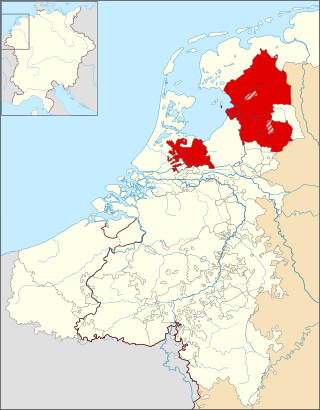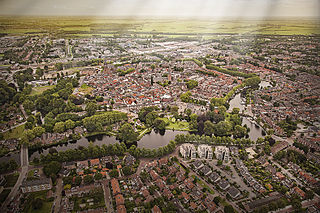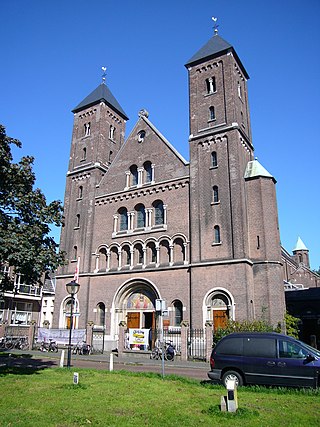External links
- C. Dekker, Geschiedenis van de provincie Utrecht (Utrecht, 1997)
Hamacarus | |
|---|---|
| Bishop of Utrecht | |
| Church | Catholic Church |
| Diocese | Archdiocese of Utrecht |
| In office | c.790–806 |
| Personal details | |
| Died | 806 |
Hamacarus was Bishop of Utrecht from around 790 to 806.
From Hamacarus nothing is known except that he was a bishop of Utrecht.
The terms Old Catholic Church, Old Catholics, Old-Catholic churches or Old Catholic movement designate "any of the groups of Western Christians who believe themselves to maintain in complete loyalty the doctrine and traditions of the undivided church but who separated from the see of Rome after the First Vatican council of 1869–70".

Utrecht, officially the Province of Utrecht, is a province of the Netherlands. It is located in the centre of the country, bordering the Eemmeer in the north-east, the province of Gelderland in the east and south-east, the province of South Holland in the west and south-west and the province of North Holland in the north-west and north. The province of Utrecht has a population of 1,353,596 as of November 2019. It has a land area of approximately 1,485 square kilometres (573 sq mi). Apart from its eponymous capital, major cities and towns in the province are Amersfoort, Houten, IJsselstein, Nieuwegein, Veenendaal and Zeist. The busiest railway station in the Netherlands, Utrecht Centraal, is located in the province of Utrecht.

Utrecht is the fourth-largest city and a municipality of the Netherlands, capital and most populous city of the province of Utrecht. It is located in the eastern corner of the Randstad conurbation, in the very centre of mainland Netherlands. It has a population of 361,699 as of December 2021.

The Bishopric of Utrecht was an ecclesiastical principality of the Holy Roman Empire in the Low Countries, in the present-day Netherlands. From 1024 to 1528, as one of the prince-bishoprics of the Holy Roman Empire, it was ruled by the bishops of Utrecht. The Prince-Bishopric of Utrecht must not be confused with the Diocese of Utrecht, which extended beyond the Prince-Bishopric and over which the bishop exercised spiritual authority.

Woerden is a city and a municipality in central Netherlands. Due to its central location between Amsterdam, Rotterdam, The Hague, and Utrecht, and the fact that it has rail and road connections to those cities, it is a popular town for commuters who work in those cities.

St. Martin's Cathedral, Utrecht, or Dom Church, is a Gothic church dedicated to Saint Martin of Tours, which was the cathedral of the Diocese of Utrecht during the Middle Ages. It is the country's only pre-Reformation cathedral, but has been a Protestant church since 1580.

The Old Catholic Church of the Netherlands, sometimes Jansenist Church of Holland, is an Old Catholic jurisdiction originating from the Archdiocese of Utrecht (695–1580). The Old Catholic Church of the Netherlands is the mother church of the Old Catholic Union of Utrecht.

The Polish National Catholic Church (PNCC) is an independent Old Catholic church based in the United States and founded by Polish-Americans.

The County of Holland was a state of the Holy Roman Empire and from 1433 part of the Burgundian Netherlands, from 1482 part of the Habsburg Netherlands and from 1581 onward the leading province of the Dutch Republic, of which it remained a part until the Batavian Revolution in 1795. The territory of the County of Holland corresponds roughly with the current provinces of North Holland and South Holland in the Netherlands.

The Archdiocese of Utrecht is an archdiocese of the Catholic Church in the Netherlands. The Archbishop of Utrecht is the metropolitan of the ecclesiastical province of Utrecht. There are six suffragan dioceses in the province: Breda, Groningen-Leeuwarden, Haarlem-Amsterdam, Roermond, Rotterdam, and 's-Hertogenbosch. The cathedral church of the archdiocese is Saint Catherine Cathedral, which replaced the prior cathedral, Saint Martin Cathedral, after it was taken by Protestants in the Reformation.
The Holland Mission or Dutch Mission was the common name of a Catholic Church missionary district in the Low Countries during and after the Protestant Reformation.
The Old Catholic Church of Austria is the Austrian member church of the Union of Utrecht of the Old Catholic Churches.

The Union of Utrecht of the Old Catholic Churches, most commonly referred to by the short form Union of Utrecht, is a federation of Old Catholic churches, nationally organized from schisms which rejected Roman Catholic doctrines of the First Vatican Council in 1870; its member churches are not in communion with the Roman Catholic Church.
The Drenther Crusade was a military campaign launched against the inhabitants of Drenthe with the approval of the Papacy in 1228 and lasting until 1232. It was led by Willibrand, Bishop of Utrecht, commanding an army composed mostly of Frisian crusaders.

David of Burgundy was the bishop of Utrecht from 1456. The illegitimate son of Philip the Good, Duke of Burgundy, David was made bishop by his father in an attempt to enforce more centralised Burgundian control over the Netherlands. He also served as bishop of Thérouanne from 1451 to 1456. He is the third longest-reigning bishop of Utrecht after Balderic and Willibrord, holding the see until his death in 1494.

Henry of the Palatinate was Bishop of Utrecht from 1524 to 1529, Bishop of Worms from 1523 to 1552 and Bishop of Freising from 1541 to 1552.

The Lordship of Utrecht was formed in 1528 when Charles V of Habsburg conquered the Bishopric of Utrecht, during the Guelders Wars.

The Bishops' Conference of the Netherlands is a permanent body within the Roman Catholic Church in the Netherlands which determines policies and directs the apostolic mission within the Netherlands. It is governed by bishops from around the country.
The historic Archdiocese of Utrecht (695–1580) was a Roman Catholic diocese and archdiocese in the Low Countries before and during the Protestant Reformation.